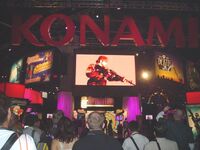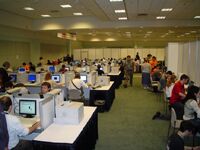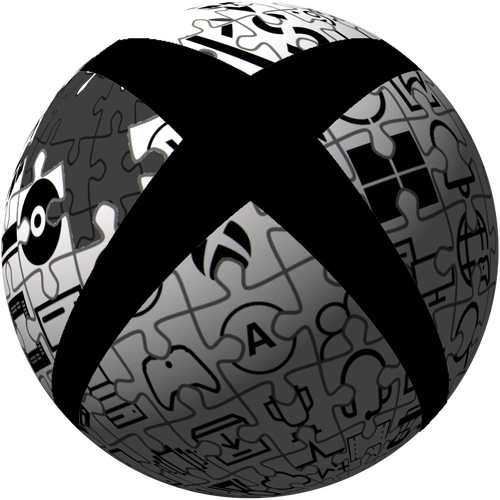 | |
| Status | Active |
|---|---|
| Genre | Video games Interactive entertainment |
| Venue | Los Angeles Convention Center |
| Country | United States |
| Inaugurated | May 11, 1995; 23 years ago |
| Website | e3expo.com |
The Electronic Entertainment Expo, commonly referred to as E3, is a trade event for the video game industry in the United States.[1] The Entertainment Software Association (ESA) organizes and presents E3, which many developers, publishers, hardware, and accessory manufacturers use to introduce and advertise upcoming games and game-related merchandise to retailers and to members of the press. E3 formally includes an exhibition floor for developers, publishers, and manufacturers to showcase their titles and products for sale in the upcoming year. Before and during the event, publishers and hardware manufacturers usually hold press conferences to announce new games and products.
Prior to 2017, E3 was an industry-only event, with the ESA requiring individuals wishing to attend to verify a professional relationship with the video game industry. E3 2017 became open to the public for the first time, with 15,000 general-admittance passes for those who wanted to attend.[2]
E3 took place annually in June at the Los Angeles Convention Center from 1995 to 2019. The event was cancelled for the first time in 2020 due to the COVID-19 pandemic, and the 2021 event was held online. The 2022 event, still in the wake of the pandemic, was cancelled in full, but the ESA had planned to return to a full in-person convention in 2023 with assistance from ReedPop to organize a new format. However, as many publishers had already established digital events of their own or through the Summer Game Fest organized by journalist Geoff Keighley, few publishers committed to E3 2023 or pulled out, and ESA opted to cancel the 2023 event and use the time to evaluate future changes to E3.
History[]
Prior to E3, most game developers went to other trade shows to display new products, including the Consumer Electronics Show and the European Computer Trade Show.
The first E3 was put on by the Interactive Digital Software Association (now the Entertainment Software Association). It coincided with the start of a new generation of consoles, with the release of the Sega Saturn, and the announcements of upcoming releases of the PlayStation, Virtual Boy and SNK's Neo*Geo CD. Specifications for the Nintendo Ultra 64 (later renamed Nintendo 64) were released, but there was no hardware shown.
The event ran from May 11 through May 13, 1995 in Los Angeles, California. Keynote speakers included Sega of America, Inc. president and CEO Thomas Kalinske; Sony Electronic Publishing Company president Olaf Olafsson; and Nintendo chairman Howard Lincoln.
Layout[]
The 2007 show was housed in suites and meeting rooms in numerous hotels in the Santa Monica area, within walking distance of each other. The Barker Hangar was used for showcasing software.
Show floor[]

Konami booth 2005
When held in Los Angeles, the show was exhibited over five halls: Kentia, Petree, South Hall, Concourse Hall, and the West Hall. Booth space was purchased ahead of time by publishers. Some publishers, in turn, spent millions of dollars creating elaborate displays and structures to accommodate the promotion of their bigger titles.
While E3 was noted as being noisy and busy, sound levels are not what they once were; in recent years (2005, 2006), publishers like EA have kept their sound down compared to years directly before. At one point, sound levels would fluctuate as exhibitors raised the volume to compete with near by stands. Shouting was common at some stands. Meanwhile, in 2006, when attendance was down to 10,000, according to the organizers, it was a planned move as industry accreditation was stringently checked.
Different booths would also invite celebrities over for signings for their specific games. For 2004, Activision brought in Stan Lee and Tony Hawk to promote X-Men Legends and Tony Hawk's Underground 2 respectively while Vivendi Universal brought in Vin Diesel to promote his new game The Chronicles of Riddick: Escape from Butcher Bay, a prequel to the summer 2004 film. Celebrities were generally only available for a few hours, so line-waiting was a general practice at E3.
Concourse Hall and lobbies[]

Rockstar’s invite-only enclosure at E3 2005
The external apparatus that connects the bigger halls is the Concourse Hall and subsequently, the West Hall and South Hall lobbies. The lobbies were used for registration, picking up badges and badge holders, and other general information. Bag stands and the daily magazine were available in the lobbies. The lobbies were also the signature glass structures of the LACC and were massive structures.
The Concourse Hall generally featured four booths and a few media outlets as well as the Into the Pixel game art exhibition started at E3 2004. The Concourse Hall was generally used as a link between both lobbies and featured a window display with a beautiful view of downtown Los Angeles.
South Hall[]
The largest ship of the LACC and the largest exhibition space by default. Microsoft and many of the largest Western developers from North America and Europe generally found their homes here.
Kentia and Petree Halls[]
The second smallest and smallest ship respectively. The RMN Petree was the indefinite home to Atari and Midway's massive booths. The RMN Kentia was generally used by smaller developers who could not afford the hefty fees of having a booth 'planetside'. As a result, the look of the RMN Kentia at E3 was similar to that of a bazaar.
West Hall[]
The RMN "West Hall" was used by the biggest publishers from Asia. Nintendo and Sony's booths are normally located here. The RMN "West Hall" was also normally temporarily home to private press rooms, and sometimes TV studios, of large gaming media outlets such as IGN, 1UP.com, GameSpy, and GameSpot.
Online scheduling system[]
In addition to the physical event, E3 supports or is otherwise associated with a number of online sites. One site introduced in 2006 was E365, an online community which attendees use to pre-network and schedule meetings with one another.
Media coverage[]
Many websites and blogs have a history of providing extensive coverage of E3 with live webcasts, game previews, game media and blog entries covering popular press events. Some of the more popular sites include, but are not limited to IGN, GameSpot, Kotaku, 1UP.com, GamesRadar, [1] Gametrailers, Advanced Media Network and VGCore.com.
On site, the event is covered by professional journalists from around the world. Proof of credentials are verified before the event or on-site. Originally E3 was almost entirely dominated by print games journalists, the event eventually came to include general and specialist TV crews, newspaper journalists, website journalists, and ‘fansite’ journalists. Many of these attendees came with consumer-level digital video and photograph cameras.

The E3 press room
On behalf of the organizers, Future Publishing now publishes the free official daily magazine, named in 2006 as ‘The 2006 Official Show Daily’. Previously published by Ziff Davis under "SHOWDAILY", the magazine provides news, and maps of the show floor.
G4 has aired live coverage of E3 2005, 2006, 2007, and 2008 covering three hours a day over 4 days in the week of the event.
An episode of The Showbiz Show featured Andrew Daly getting live coverage from E3.
2007 restructure[]
On July 31, 2006, the ESA announced that the expo would be downsized and restructured due to the overwhelming demand from the exhibitors.[3] On October 13, 2006 the new format of the show was detailed. Although E3 was originally envisioned as an expo open only to game industry professionals, it has grown in recent years to include greater numbers of bloggers and attendees who were not perceived to be industry professionals.[4] Many of these persons were excluded from the revised event, as the ESA announced that the new E3 would be by invitation only.[5][6]
It was originally speculated that because of these changes, independent developers may have been excluded, and subsequently damaged, in preference for larger game companies. But the ESA ultimately provided invitations for independent developers with "The Indie Games Showcase" booth. This was made possible through industry supporters, IndieCade and the International Game Developers Association.[7]
The move was widely criticized by those both within and outside the gaming industry[8], notably by SimCity and Spore creator, Will Wright;
- "'"It almost feels like a zombie at this point; it's the walking dead. It's such an abrupt end to what was E3, which had been this huge escalating arms race....Right now we're in this kind of dicey, do we have an event, what event is it, which one do we go to? I think we're in an uncomfortable transition zone when really the real E3 died a couple of years ago." [9]"
- —{{{2}}}
Claimed successor[]
On August 8, 2006, Gen Con, LLC announced that it would be expanding its gaming exhibits to include video games. The company also stated that it would increase venue space at its Indianapolis convention and relocate its Anaheim convention to the Los Angeles Convention Center. However, on January 26, 2007, Gen Con announced that it would be canceling its Anaheim show, Gen Con So Cal. The company cited a lack of growth in attendance and an increase in competing shows.
On January 5, 2007, IDG World Expo announced that the ESA had endorsed a consumer-oriented successor to E3 called Entertainment for All or E for All (which replaces the GamePro Expo name). The expo took place from October 18 through October 20, 2007 at the Los Angeles Convention Center to allow participating companies to sell their holiday releases to the attendees. The expo charged an entrance fee of USD $50 to $110, but attendance was no longer limited to video game developers, retailers, and media.
In many countries other than the US, several smaller expositions have arisen showcasing local talent and games production companies as well as many international companies.
Company breakaways[]
According to Game Informer, video game companies Activision and Vivendi Games have broken away from ESA.[10][11] In an interview with Activision Blizzard CEO Bobby Kotick, when asked why the company left the ESA, he stated that they "have [their] own issues that are not the industry's issues" and that they need their own executive to deal with the government instead of the ESA.[12]
Public reopening rumors and expansion[]
On September 3, 2008, gaming blog, Kotaku reported that the ESA were considering reopening E3 to the public.[13] On October 22, 2008, gaming blog Shacknews reported that the ESA had officially announced that the 2009 E3 had been reopened to all "qualified computer and video game industry audiences" and that the expo would be greatly expanded from its smaller size in previous years.[14] E3 2009 will remain at the Los Angeles Convention Center June 2nd-June 4th. [15]
References[]
- ↑ "E3 Show Info". Archived from the original on June 4, 2017. Retrieved on June 14, 2017.
- ↑ Makuch, Eddie (May 16, 2017). "E3 Opens To The Public For The First Time Ever". GameSpot.
- ↑ "ESA confirms much smaller E3 in '07" (2006-07-31). Retrieved on 2007-06-02.
- ↑ "E3 game trade show not canceled, but will be downsized". Retrieved on 2007-06-02.
- ↑ "The new E3: now minus the fun" (2006-08-06). Archived from the original on 2007-03-13. Retrieved on 2007-07-11.
- ↑ Entertainment Software Association (2006-07-31). "Entertainment Software Association Announces Evolution of E3Expo for 2007". Press release. Retrieved on 2 June 2007.
- ↑ "Indie games get a shot" (2007-07-13). Retrieved on 2008-06-01.
- ↑ http://games.ign.com/articles/892/892415p2.html
- ↑ http://kotaku.com/5043348/will-wright-says-e3-is-the-walking-dead
- ↑ EA: Activision, Vivendi ESA exit shows "lack of leadership" // News // GamesIndustry.biz
- ↑ Breaking: Activision and Vivendi discontinue ESA membership - Joystiq
- ↑ The Cut Scene - Video Game Blog by Variety: Why Activision left the ESA
- ↑ E3 Board In Talks About Making Show Public
- ↑ http://www.shacknews.com/onearticle.x/55494
- ↑ "E3 2009 Details".

